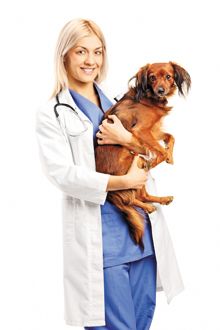Is it time for the veterinary nurse practitioner?
Could this new role solve a host of problems facing the veterinary profession?

Getty Images
When veterinarians and veterinary technicians become credentialed and take their posts, we take a professional oath expressing our commitment to benefit the society through better animal health and welfare, preventing and relieving animal suffering, promoting public health and advancing the field through lifelong learning. The field currently faces challenges preventing us from completely fulfilling our oath.
The challenges-and a possible solution
Rising costs mean many pet owners perceive veterinary care as unaffordable, and this triggers negative opinions of veterinary practices. Pet owners are often unaware of the validity of these costs, even as veterinarians and veterinary technicians earn a salary significantly lower than our human medicine counterparts.
Graduates struggle to pay off their debts from rising tuitions while working longer hours or multiple positions, making burnout and compassion fatigue common. The result: many leave the field. In the meantime, the employment gap between small animal veterinary professionals in populated areas and large animal veterinary professionals in rural areas is widening, making veterinary care in some areas inaccessible.
One solution: a midlevel veterinary professional program proposed by Colorado State University, designed to train veterinary professional associates (VPAs) serving the role of a physician assistant (PA) to a physician or dental hygienist to a dentist.
The goal of a midlevel professional is to allow practices to generate more revenue while keeping costs low and create capable professionals who will reach underserved areas.
But how do we get there?
A first step: NAVTA recently announced their effort to establish a nationally standardized credentialing requirement for veterinary technicians and a title change to veterinary nurse. As the association explores these changes, it's pertinent to look further ahead and think of a possibility of a nurse practitioner-like role in veterinary medicine.
Both PAs and nurse practitioners (NPs) in human medicine are able to examine, diagnose and treat patients for both acute and chronic conditions. NPs practice independently of physicians or under a physician's license, depending on the state's regulations, and they tend to specialize in specific areas.
Veterinary technicians in the field today bring a significant amount of education, experience and value to a practice, performing tasks that can start with taking a history and performing physical exams to implementing complicated treatment plans for hospitalized patients and managing the care while consistently reassessing the patient to be the hands, eyes and ears of the veterinarian.
What could a nurse practitioner do for the profession?
What if our profession created a structure to train veterinary nurse practitioners (VNPs), where the brightest of these team members were given a path to contribute further?
What if VNPs were able to perform wellness exams, prescribing preventive medications to keep our patients healthy while the veterinarian is able to focus more time on the treatment of complicated cases that require dedicated attention?
These individuals would also increase the pool of professionals who will serve the large animal and rural areas. They could also help alleviate some of the overtime veterinarians feel forced to endure with additional help of higher capacity.
What if VNPs became a contact point for veterinary technicians and assistants to seek advice regarding continuation of therapy for existing patients, without the veterinarian being required to approve it? For example, they might refill a prescription of a nonsteroidal anti-inflammatory drug after reviewing liver and kidney values, or modify a pain management protocol for a hospitalized postoperative patient by adding a constant rate infusion to overcome breakthrough pain.
What if VNPs specialized in anesthesia were able to apply their education to maintain the septic patient suffering from a surgical accident during an abdominal exploratory leading to severe hemorrhage and hypotension-without the veterinarian's intervention-through the use of intravascular volume replacement, blood transfusion and implementation of partial to total intravenous anesthesia, so the veterinarian could focus on the surgery?
All of these examples currently require a second veterinarian to fill the role.
The right steps
VNPs should be adequately regulated with a clear scope of practice to serve a role that integrates into the current team and delineates them from the role of veterinarians and veterinary technicians. Establishing academic pathways similar to RNs, requiring a master's or doctorate degree to become NPs, is a critical step to ensure appropriate education. There are currently individuals practicing as veterinary technician specialists through a rigorous certification process and those who have achieved master's degrees in related fields who are prime candidates to practice at a higher caliber.
I'd like to pose a challenge to those within the veterinary field to take a close look at the veterinary technicians on the team, utilize them to their fullest potential, provide them with the opportunity to obtain further continuing education and imagine a future where some of these individuals will serve in the midlevel role to expand the veterinary team. The path to this future seems a vast challenge. But, as the veterinary technician profession is on a path to rapid progress, now is the time to start the conversation.
Kenichiro Yagi, BS, RVT, VTS (ECC, SAIM), practices at Adobe Animal Hospital in California as an ICU and Blood Bank Manager.